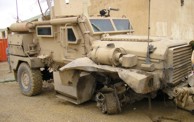 |
||||||||
|
|
|
||||||
|
See also
September 28, 2011 ISSA Future Battlefield Research Team Develops New Technologies to Match its New Concepts ISSA studies have long focused on energy security and linked those studies to water security and resource issues and geopolitics. Its 2011 study, Energy Security 2.0, for example, linked those issues concretely. [The PDF ebook of that entire study can be downloaded free by clicking here (3.5MB).] Some of the results of these studies were framed in strategic context in studies on the New Battlefield, published in ISSA’s Defense & Foreign Affairs journals [click here], and in lectures by ISSA Pres. Gregory Copley to the US Army War College [click here] and US Special Operations Command and US African Command (USAFRICOM) [click here], as well as in a look at the impact on future warfighting of the lessons of the Japanese 2011 tsunami [click here]. This conceptual work led to the creation of a team under the leadership of ISSA to actually see whether the technologies envisaged by the concept team could be brought into reality for expeditionary warfare and expeditionary relief operations. this, by late September 2011, had already resulted in the creation of some seven specific new systems which could revolutionize expeditionary deployment, generating self-sustaining electrical power for deployed forces, and generating electrically-operated or manually-operated ultra-light, ultra-clean water purification (to 0.01 microns) and desalination systems for forward-operating forces and relief operators. These systems will transform security and civil operations in remote locations in the coming years. ISSA Releases Findings of Study into US Military Vehicle Safety
The International Strategic Studies Association on June 25, 2007, released the findings of a study entitled Considerations on Defense Force Personnel Survivability in Vehicle Incidents Under Urban Warfare Conditions, which said that the new range of US Army and Marine Corps MRAP (Mine Resistant Ambush Protected) vehicles to be deployed to Iraq were not yet ready to meet the full nature of the threat from improvised explosive devices (IEDs), and other threats. The study made a number of recommendations to quickly redress much of the problem, including the installation of readily-available seating and harness systems which addressed the problem of "slam-down" and attendant two-stage energy attenuation (EA) caused by the secondary effects of bomb blasts. The study noted: “premature deployment of new MRAP and up-armored M1114s (and other variants of the HMMWV), had it occurred — as demanded by media reports — would have added enormous cost to the Iraq operational deployment without the commensurate increases in safety which are now possible.” Click here to see the full report in html or PDF format. Follow-up Paper, July 3, 2007: US Defense Force Personnel Remain Vulnerable as New Vehicle Systems Enter Production Without Appropriate Survivability Systems. Click here for PDF. Click here for html. Second Follow-up Paper, October 8, 2007: Some Progress, But Major Failings, in Getting Viable Survivability Systems into New US Armed Forces Vehicles. Click here for PDF. Click here for html. Third Follow-up Paper, February 16, 2008: New Survivability Systems Validated for US Armed Forces Vehicles, But Unsafe MRAPs, HMWWVs Still Being Deployed. Click here for PDF. Click here for html. |
||||||||



